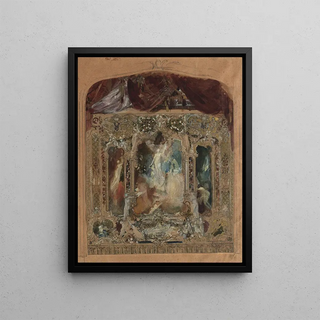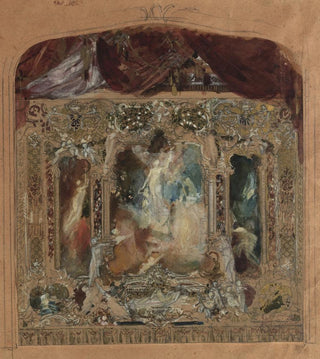Art print | Project for the curtain of the Reichenberg theater - Gustav Klimt


View from behind

Frame (optional)
Reproduction Project for the Reichenberg theater curtain - Gustav Klimt – Captivating Introduction
The "Project for the Reichenberg theater curtain" by Gustav Klimt is an iconic work that embodies the very essence of Art Nouveau, an artistic movement that revolutionized the perception of art at the turn of the 20th century. This creation, although designed for a theatrical space, transcends its primary utility to become a true work of art in its own right. Klimt, with his bold approach and enchanting motifs, manages to capture the collective imagination of his era, blending sensuality and symbolism. This project, which never saw the light of day in its original form, remains nonetheless a masterpiece of his repertoire, testament to his creative genius and his ability to fuse art and life.
Style and uniqueness of the work
Klimt's style is characterized by a richness of detail and a daring use of colors, which manifest vividly in this project. Floral motifs, stylized figures, and textured patterns intertwine to create a captivating visual universe. The work stands out for its dynamic composition, where each element seems to dance across the canvas, evoking movement and fluidity. Byzantine influences, visible in the use of gold and geometric patterns, blend with more contemporary elements, creating a dialogue between the past and modernity. The sensuality emanating from this work is palpable, revealing themes of love, beauty, and nature, which are dear to the artist. Klimt thus manages to create an atmosphere that is both intimate and universal, inviting the viewer to immerse themselves in a world of dreams and fantasies.
The artist and his influence
Gustav Klimt, born in 1862 in Baumgarten, Austria, is one of the most influential artists of his time. A member of the Vienna Secession, he played a key role in the emergence of Art Nouveau in Europe. His work, marked by bold explorations of themes of sexuality, femininity, and spirituality, paved the way for many contemporary and future artists. Klimt was able

Matte finish

View from behind

Frame (optional)
Reproduction Project for the Reichenberg theater curtain - Gustav Klimt – Captivating Introduction
The "Project for the Reichenberg theater curtain" by Gustav Klimt is an iconic work that embodies the very essence of Art Nouveau, an artistic movement that revolutionized the perception of art at the turn of the 20th century. This creation, although designed for a theatrical space, transcends its primary utility to become a true work of art in its own right. Klimt, with his bold approach and enchanting motifs, manages to capture the collective imagination of his era, blending sensuality and symbolism. This project, which never saw the light of day in its original form, remains nonetheless a masterpiece of his repertoire, testament to his creative genius and his ability to fuse art and life.
Style and uniqueness of the work
Klimt's style is characterized by a richness of detail and a daring use of colors, which manifest vividly in this project. Floral motifs, stylized figures, and textured patterns intertwine to create a captivating visual universe. The work stands out for its dynamic composition, where each element seems to dance across the canvas, evoking movement and fluidity. Byzantine influences, visible in the use of gold and geometric patterns, blend with more contemporary elements, creating a dialogue between the past and modernity. The sensuality emanating from this work is palpable, revealing themes of love, beauty, and nature, which are dear to the artist. Klimt thus manages to create an atmosphere that is both intimate and universal, inviting the viewer to immerse themselves in a world of dreams and fantasies.
The artist and his influence
Gustav Klimt, born in 1862 in Baumgarten, Austria, is one of the most influential artists of his time. A member of the Vienna Secession, he played a key role in the emergence of Art Nouveau in Europe. His work, marked by bold explorations of themes of sexuality, femininity, and spirituality, paved the way for many contemporary and future artists. Klimt was able






